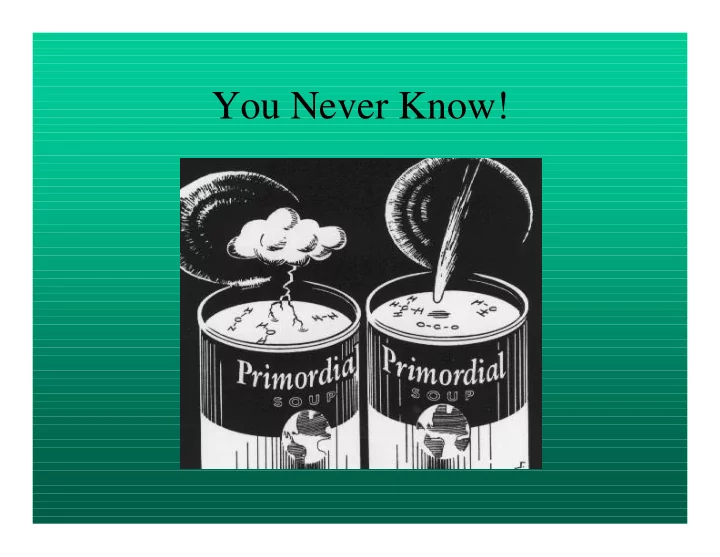

You Never Know!
How did it all begin?
Darwin's Theory of Natural Selection. • Fact #1 - Without constraints, populations will grow exponentially, producing an ever more rapidly growing number of organisms. • Fact #2 - In spite of this prediction, the numbers of individuals in a population remains near equilibrium, fluctuating above and below some mean value. Why? • Fact #3 - Resources are limited. From these three facts, Malthus concluded that there was a struggle for existence.
Darwin’s Theory (Cont.): Darwin combined this with two addition facts: • Fact #4 - Sexually reproducing individuals are unique. There is individual variation across a population. • Fact #5 - Much (but not all) of the individual variation is heritable. This observation came from animal breeders. (Some of observed variation is environmental, some is genetic.) These facts led Darwin to the conclude that some individuals are better equipped to survive and reproduce than others. This process came to be known as Natural Selection. • Through many generations of time, evolution is the result. (Darwin used "descent with modification.")
If the hypothesis of evolution is true: • We must be able to obtain information on organisms that lived in the past • The species that lived in the remote past must be different from the species alive today and there is less of a chance of finding contemporary species. • Expect to find the simplest organisms in the oldest fossiliferous strata and the more complex species in more recent strata. • It must be possible to demonstrate the transformation of one species into another. • There must be intermediate links among species. • The age of the earth must be very great.
Species Concepts • The Typological Species Concept • The Nominalistic Species Concept • The Biological Species Concept – How would you define a biological species?
Some Patterns of Evolution • Gradualism explains speciation as the slow, steady accumulation of small changes over time. • Punctuated equilibrium explains speciation as occurring relatively rapidly amid long periods of little change. • Gradualism and punctuated equilibrium models can both be applied to the evolution of many organisms. • Many evolutionary biologists accept a synthesis of gradualism and punctuated equilibrium.
Potential Modes of Origin of Species • Transformation of Species (phyletic speciation) • Reduction in number of species (fusion of species) • Multiplication of Species (true speciation) – Instantaneous speciation (through individuals) • Genetically through mutation • Cytologically through translocation and polyploidy – Gradual Speciation through populations • Sympatric Speciation • Allopatric Speciation – Isolation of a colony and aquisition of isolating mechanisms
Allopatric Speciation
Models of Speciation
The Hardy-Weinberg Law The frequency of genes in a large population remains constant in the ABSENCE of • Mutations • Immigration • Emigration • Reproduction must be random The Bottom Line: Populations are continually evolving as noted by changes in gene frequency
Examples of the Effects of Natural Selection on Gene Frequencies • Directional Selection – Changing environmental conditions populations can evolve along a particular functional line • Stabilizing Selection – Environmental factors may cause a population to evolve where the most common gene frequencies are favored while the rarer frequencies are selected against • Disruptive Selection – It can sometimes happen that a polygenic character is subject to two or more opposing directional selection pressures. (i.e. bird beak size)
Factors Influencing Genetic Variation • Sources of Genetic Variation – Occurrence of new genetic factors a. Mutation b. Gene flow form other populations – New genotypes through recombination • Factors Eroding Variation – Natural Selection – Chance and accident
Meosis-Reshuffling the Deck!
Mixing it Up!! Playing Solitare till Dawn with A Deck of 51!
Protection of Genetic Variation • Cytophysiological and development devices – Complete recessiveness – Superiority of heterozygotes • Ecological Factors – Change of selection pressure over time – Geographic variation of the environment and gene flow – Selective advantage of rare genes
Reproductive Isolating Mechanisms • Premating Mechanisms that prevent interspecific crosses – Potential mates do not meet (seasonal and habitat isolation) – Ethological isolation (Potential mates meet but don’t mate) – Mechanical isolation (No sperm transfer takes place) • Postmating Mechanisms that reduce success – Sperm transfer takes place but egg not fertilized – Egg fertilized but zygote dies – F1 hybrid of reduced viability – Hybrid Sterility- F1 hybrid is fully viable but may be sterile
Reproductive Isolating Mechanisms • Behavioral Isolation – Visual • Fireflies, humans – Auditory • frogs, birds, crickets – Chemical • Pheremones in insects, humans?
Recommend
More recommend